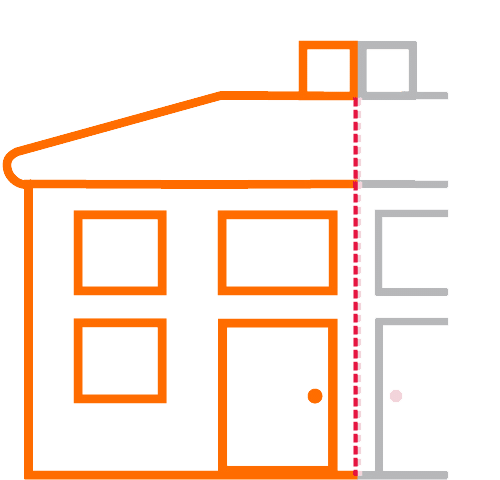While there's no direct legal requirement for homeowners to install loft insulation in existing properties, you'll need to meet specific standards in certain situations. If you're building a new home, converting a loft, or renting out property, you must comply with current building regulations that mandate a minimum insulation depth of 270mm. For rental properties, you'll need to achieve at least an EPC rating of 'E' to legally let the property. Meeting these standards can save you up to £395 annually on energy bills and reduce your carbon footprint by 990kg per year. Understanding the full scope of regulations and requirements can help you make informed decisions about your property's insulation needs.
Building Regulations and Standards
Table of Contents
ToggleBritain's building regulations set clear standards for loft insulation, with current guidelines requiring a minimum depth of 270mm for installations completed after 2003. If you're working with an older installation, you'll need to be aware that the previous standard called for 200mm, though you may want to contemplate upgrading to meet current specifications.
You'll find that Part L of the Building Regulations plays a vital role in determining the requirements for your loft insulation, as it establishes the energy efficiency standards you'll need to meet.
When you're selecting materials, you must guarantee they're non-combustible and comply with specific fire safety standards outlined in the regulations. This becomes particularly important if you're planning a loft conversion, where you'll need to obtain approval from Building Control before proceeding.
Your responsibilities don't end with installation, as regulations may require periodic inspections to verify that your loft insulation maintains its effectiveness over time.
These inspections help confirm your insulation continues to meet current standards, which can change as building regulations are updated to reflect new energy efficiency requirements.
Legal Framework for Loft Insulation
The regulatory landscape for loft insulation in the UK combines both mandatory and voluntary requirements. While there's no direct legal obligation to install loft insulation in your home, you'll find that building regulations have established clear guidelines, including the recommended minimum depth of 270mm since 2003. This standard represents a significant increase from the previous 200mm requirement, reflecting the government's growing emphasis on energy efficiency.
If you're a landlord, you'll need to pay particular attention to the Minimum Energy Efficiency Standards (MEES), which require your rental properties to achieve at least an 'E' rating on their Energy Performance Certificate. While this doesn't explicitly mandate loft insulation, you'll likely need adequate insulation to meet these standards.
Additionally, if you're planning to sell your property, inadequate insulation that doesn't meet building regulations could affect the sale process and your insurance coverage.
To support these requirements, you can take advantage of the Energy Company Obligation (ECO) scheme, which provides funding assistance for loft insulation installations, making it easier to comply with current standards and improve your home's energy efficiency.
Energy Performance Certificates
Modern property transactions hinge on Energy Performance Certificates (EPCs), which provide essential information about a building's energy efficiency rating.
You'll need to evaluate your property's EPC rating carefully, as it directly impacts both its market value and compliance with current regulations.
If you're a landlord, you must guarantee your property meets the minimum EPC rating of E to legally rent it out in England and Wales.
Your property's loft insulation plays a vital role in achieving this rating, and you'll find that inadequate insulation can greatly lower your EPC score.
When you're selling or letting a property, potential buyers or tenants will examine the EPC rating as part of their decision-making process.
You can improve your property's EPC rating by upgrading your loft insulation, which won't just help you meet legal requirements but will also enhance your property's marketability.
The assessment takes into account various energy efficiency factors, and proper loft insulation stands as one of the most effective ways to boost your rating.
Rental Property Requirements
Rental properties in England and Wales must meet strict insulation standards that you'll need to follow as a landlord. Under the Energy Efficiency Regulations of 2015, you're required to guarantee your property achieves at least an EPC rating of E before it can be legally rented out, with properties rated F or G being regarded as substandard for tenancy.
As part of these requirements, you must install adequate loft insulation that meets current standards, with the government recommending a minimum depth of 270mm for ideal energy efficiency.
You'll find that proper insulation not only helps your tenants reduce their heating costs but also confirms you're complying with legal obligations. If you don't meet these standards, you could face significant penalties, including fines and restrictions on your ability to rent out the property.
Additionally, your tenants have the right to request improvements to the property's insulation, and it's in your best interest to take these requests seriously.
New Construction Guidelines
Building regulations established in 2003 set clear standards for loft insulation in new UK constructions, requiring a minimum depth of 270mm to guarantee peak energy efficiency.
If you're planning a new build, you'll need to confirm your insulation materials comply with both thermal performance requirements and fire safety regulations, while avoiding materials that release harmful pollutants.
When you're considering a loft conversion in your new construction, you'll need to obtain Building Control approval, which typically requires warm loft insulation fitted directly to the roof's underside.
This specific requirement differs from standard loft insulation and plays a vital role in meeting overall energy performance standards.
You'll find that these guidelines aren't optional – they're mandatory components of the wider sustainability initiatives within the construction sector.
If you don't comply with these insulation requirements, you're likely to face significant consequences.
You could be subject to penalties, and you'll need to make potentially expensive modifications to bring your property up to code.
It's more cost-effective to confirm your new construction meets these standards from the outset rather than dealing with corrections later.
Recommended Insulation Depths
While insulation standards have evolved over time, current regulations specify a minimum depth of 270mm for loft insulation – a significant increase from the pre-2003 requirement of 200mm.
You'll find that this updated standard reflects modern energy efficiency requirements and helps create more sustainable homes.
To determine if your loft meets these recommendations, you'll need to measure your existing insulation's thickness. If you're finding that your insulation falls short of the current 270mm guideline, you're likely experiencing unnecessary heat loss and higher energy costs.
The impact of insufficient insulation can be substantial, affecting both your comfort and your wallet.
The financial benefits of meeting these depth requirements are compelling, as you could save up to £395 annually on your energy bills by ensuring proper insulation levels.
When you're evaluating your loft's insulation, remember that these standards aren't arbitrary – they're based on extensive research into ideal energy efficiency.
Compliance and Enforcement
In contrast to common belief, there's no universal legal requirement for loft insulation in existing homes, though building regulations strongly recommend the 270mm minimum depth.
However, you'll need to comply with current building standards if you're constructing a new property, as these regulations mandate proper roof insulation for energy efficiency.
You should be aware that local authorities can enforce energy efficiency standards, particularly during property transactions or renovations.
If you're a landlord, you'll need to pay special attention to these requirements, as failing to meet local energy efficiency regulations for rental properties could result in penalties or compliance issues.
Additionally, if you're planning to access government funding through programs like the Green Deal or ECO grants, you'll find that meeting specific insulation standards is often a prerequisite for financial assistance.
These schemes effectively encourage homeowners to upgrade their insulation to current standards, even though it's not strictly mandatory for existing properties.
While the regulations might seem complex, they're designed to promote energy efficiency and reduce heat loss in residential buildings across the country.
Cost and Financial Support
The financial investment in loft insulation pays significant dividends over time, with homeowners potentially saving up to £395 annually on energy bills.
You'll find that the initial costs vary depending on whether you choose a DIY approach or professional installation, but the long-term benefits make it a worthwhile investment for your property.
To help manage the upfront costs, you can access various financial support options, including Green Deal financing and ECO grants, which make loft insulation more affordable for qualifying homeowners.
When you consider that insulation can remain effective for over 40 years, the investment becomes even more attractive from a cost-benefit perspective.
If you're currently living in a poorly insulated home, you're likely paying higher energy bills and contributing unnecessarily to carbon dioxide emissions.
The math is straightforward: the one-time cost of installation, especially when offset by available grants, will be recovered through reduced heating costs over the following years.
Whether you choose to install the insulation yourself or hire professionals, you'll find that the long-term financial advantages make it a sound investment for your property.
Environmental Impact Considerations
Making your home environmentally friendly starts with effective loft insulation, which can slash carbon dioxide emissions by up to 990kg annually.
When you consider that poorly insulated homes contribute considerably to unnecessary greenhouse gas emissions, you'll understand why proper insulation plays an essential role in combating climate change.
You're making a substantial environmental impact when you invest in loft insulation, as it's designed to last for over four decades.
During this time, you'll not only reduce your carbon footprint but also minimize overall energy waste through improved temperature regulation.
The environmental benefits are twofold: you're decreasing your home's energy consumption while simultaneously supporting broader sustainability goals.
By maintaining consistent indoor temperatures, you're reducing the strain on heating and cooling systems, which directly correlates to lower energy usage and decreased environmental impact.
When combined with potential energy bill savings of up to £395 per year, you'll find that loft insulation represents a practical solution that aligns both environmental responsibility and financial efficiency, making it a wise choice for environmentally conscious homeowners.





